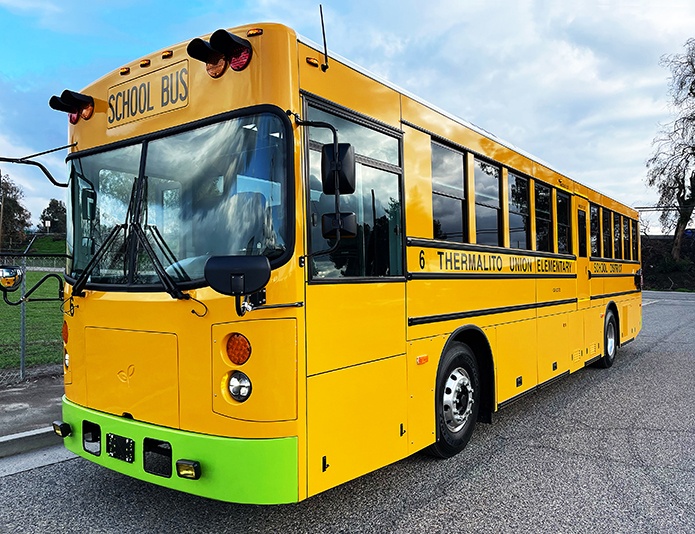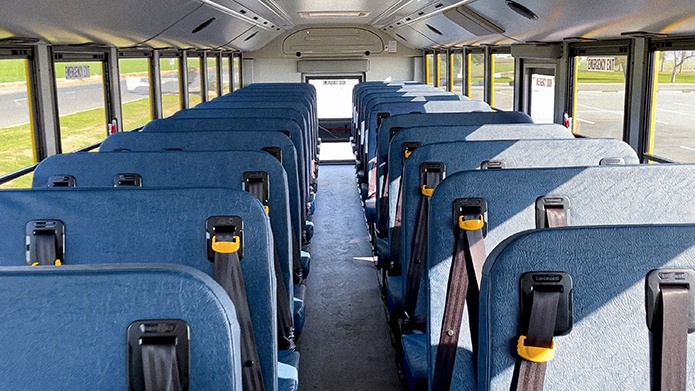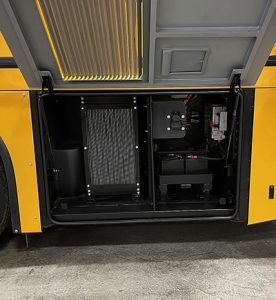
The Battery Electric Automotive School Transportation (BEAST) is a 40-foot, 90-passenger Type D school bus, purpose-built for electric drive
GreenPower Motor Company formed in 2010 and began its first bus deliveries to transit agencies by 2017. Although the company initially focused on full-size transit buses and its EV Star model (a purpose-built all-electric shuttle bus), GreenPower quickly saw an opportunity to expand into school buses.

The manufacturer’s first school bus was the 36.5-foot Synapse 72, and it delivered five models to southern California districts in 2019 for Rialto USD, Placentia Yorba Linda USD, and Paso Robles US. After those deployments, according to GreenPower Vice President of Sales and Marketing Ryne Shetterly, the company re-evaluated its offerings to pupil transportation.
“The 36.5-foot variant, formally known as the Synapse 72 did not distinguish itself from the pack and we knew we had room for tremendous improvement,” he said.
 “Over the course of three deliveries in southern California, we learned that it was probably time to go ‘back to the drawing board,’” he said. “So that’s what we did – we re-calibrated our approach.”
“Over the course of three deliveries in southern California, we learned that it was probably time to go ‘back to the drawing board,’” he said. “So that’s what we did – we re-calibrated our approach.”
Working on the same chassis – now elongated to 40 feet – GreenPower developed the Battery Electric Automotive School Transportation (BEAST) bus. The BEAST, Shetterly said, is the first commercially available purpose-built Type D school bus on the market.
“The BEAST is a 40-foot, 90 passenger school bus with more range, dual charging capabilities, and more standard features than anything else on the market,” he said. “School districts went wild when unit one rolled off the line, and we haven’t looked back since.”
“Many manufacturers are building their battery bus models on the exact same chassis as their diesel buses,” he added. “The BEAST begins its life as a zero emissions vehicle and represents a ground-up build for all-electric pupil transportation.”
The BEAST is constructed with a Monocoque chassis and aluminum body, resulting in a super-lightweight Type-D vehicle. Every BEAST vehicle features standard air-ride suspension, ABS disc brakes, air conditioning, and pass-through storage.
The BEAST has a seating capacity of up to 90 passengers. This is a key differentiator from its closest competitor, which has an 87-passenger capacity.
The vehicle’s battery generates 194 kilowatts (kw) per hour, providing a range of up to 150 miles on a single charge. With a dual-charging capacity, the AC onboard charger reaches up to 20 kw and the DC charger can fast-charge up to 60 kw.
“A DC fast-charger is going to take something like 2 hours and 15 minutes,” Shetterly said. “The AC charger will charge at 20 kw overnight, lasting about 6.5 hours. But we do not require school districts to make that decision up front – it’s important that we meet their needs for reliability and duty cycles above all else.”
GreenPower partnered with Creative Bus Sales for a come-to-market strategy focusing on California deployments. In California, GreenPower intends to add certifications, incur miles driven, and receive driver and passenger feedback on the BEAST.
“We are looking to develop the best product possible, and that means we need as much data as possible,” Shetterly said.
The BEAST differences
Shetterly said that GreenPower is not necessarily in the school bus market to directly compete with electric vehicle converters, which build hundreds of buses per day to achieve scale. GreenPower looks at the BEAST bus as a standalone product.
“BEAST is not necessarily the cheapest all-electric vehicle on the market, nor is it the most expensive,” he said. “However, we are the only company delivering an ‘as-is’ Type D, all-electric bus with all the necessary equipment for a customer looking to adopt electric propulsion.”
One of the BEAST’s key differentiators is efficiency. With current gas prices, GreenPower estimates that districts can achieve a 70 percent reduction in operational savings by switching from diesel-fueled buses to the BEAST. This includes fuel costs, fluid maintenance, oil changes, transmission services, and other operational expenses.
Pairing those costs with electric vehicle incentives, plus a reduction in day-to-day maintenance costs – districts can start seeing a return on investment on “day one.”
The battery system is ambient controlled, and a thermal management system keeps the batteries within a specific ambient range that will increase battery life over time. This becomes especially important in very cool or warm clients.
Serviceability is another factor in the BEAST’s difference. With battery packs located within the superstructure, drivers and maintenance techs will have a much easier time during walk-around inspections. Not only that, but by strategically placing the battery packs in optimal locations, the BEAST offers a very quiet, balanced ride.
Shetterly said that GreenPower estimates districts will see a 30 to 50-percent increase in overall brake life over competitive models because of the regenerative braking which is programmable on a district-by-district basis.
“For us, the longevity factor is critical,” he said. “We understand that our customers are spending good, hard-earned money. Whether or not the purchase is subsidized, someone is paying for it. We want that investment to resound for years and show both sides of the aisle that what we’re doing makes sense.”
“Districts really can lower emissions and lower operation costs at the same time,” he said.
Making deliveries
Today, GreenPower has 100 BEAST school buses in production. In 4Q2021, the company delivered six units to Thermalito Union Elementary School District (UESD) four units to Anaheim Union High School District, and one unit to Santa Maria Joint Union High School District – all in California.
“After receiving our CHP 292 certification here in California, we are looking east and starting to expand our dealer network,” Shetterly said. “We’re excited for the next 180 days, which I think is going to represent an absolute tidal wave for zero emissions school buses.”

Thermalito USD
Thermalito UESD in Oroville, California, worked with the Butte County Air Quality Management District (part of the California Air Resources Board [CARB]) and the California Energy Commission (CEC) throughout 2018 to plan its first electric bus deployment. Butte County Air Quality Management District allotted $468,000 toward the district’s first bus and corresponding infrastructure, while the CEC allotted $1.95 million for five more buses and necessary infrastructure.
After finalizing its funding sources and infrastructure planning, the district began taking demos of various electric school buses on the market.
“We saw many other California districts purchasing one or two electric vehicle units at a time, with decent success,” said Andrew Koster, director of maintenance operations and transportation for Thermalito UESD. “We saw other buses on the road and realized that our routes were similar in length – so we decided to give all-electrics a try.”
The district was very interested in the prospect of purchasing Type D buses, citing the transit-style for greater visibility and increased seating capacity. GreenPower and Creative Bus Sales visited Oroville for a test drive, the results of which greatly impressed Thermalito’s superintendent, assistant superintendent, selected board members, and drivers.
 Now, with six vehicles preparing to enter route service, Thermalito is essentially pioneering the BEAST in northern California.
Now, with six vehicles preparing to enter route service, Thermalito is essentially pioneering the BEAST in northern California.
“Right away, we saw that the turning radius of the BEAST Type D is amazing,” Koster said. “Furthermore, the ride quality on the air ride suspension is far superior to any bus in our fleet. Pairing this system with a Recaro seat provides exceptional comfort to our drivers.”
“The drivers felt very comfortable, which is a huge plus for a bus of this size,” he continued. “There is so much going on day-to-day in a bus. We want our drivers to focus on the road and students, and less on shakes, bumps, or noises from the drive.”
Thermalito’s maintenance department installed the charging stations and switchgear, and Pacific Gas & Electric installed the district’s power service. As of January, all the district’s Blink charging stations are fully operational.
When production of the BEAST vehicles entered its final phase, GreenPower and Creative Bus Sales invited Koster to the factory for a quality check.
“The fit and finish were exceptional – all of the body line, trim work, and rubber around the windows and doors are very tight,” he said. “I think those tight tolerances are what makes the BEAST especially quiet. It’s also the best-looking electric school bus that we’ve ever seen.”
“We’re very much looking forward to getting these out on the road.”
Shetterly credits the vehicle’s robustness and purpose-driven build as the two factors which most impressed Thermalito and other districts.
“People understand the difference between a purpose-built vehicle and a converted vehicle, and they understand it right away,” Shetterly said. “The BEAST doesn’t have a rear-engine compartment ‘hump.’ It has a fully flat floor with no wheel wells, allowing for the extra seats. People instantly recognize the wider door and wider aisle. The entire bus feels more sturdy than other electric vehicles, because the chassis and body structures are built around the energy storage.”
Once districts drive the vehicle, most comments center around the bus’s lack of noise and better pickup compared to its closest competitors.
Shetterly said that this is affectionately called the GreenPower Trust Factor. The vehicle reassures customers and districts that the vehicle’s design is well researched, safe, and reliable.
“We are not ‘blitzing’ the market,” he said. “We are expanding steadily, gathering data, and allowing the BEAST to grow organically as more districts get to experience the vehicle.”
“At the end of the day, we want to do this correctly,” he continued. “We want to bring a vehicle to market that is going to be reliable, serviceable, durable, environmentally-friendly, and get these students back and forth to where they need to go safely.”


